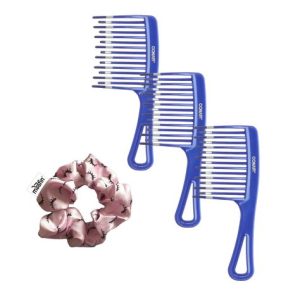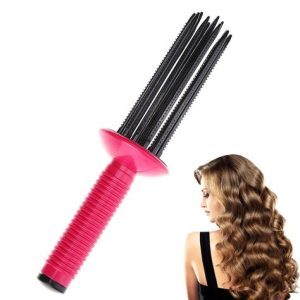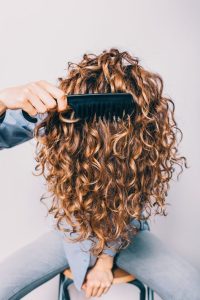Curly hair is a beautiful and unique texture, but it also comes with its own set of challenges. One common question curly-haired folks ask is whether they should comb their hair. The answer depends on several factors, such as curl pattern, hair health, and desired style. This article will explore the pros and cons of combing curly hair, offering tips for detangling and maintaining healthy, defined curls.
Understanding Your Curl Pattern
-
2A – Wavy: Hair has a slight S-shaped wave that may not hold a curl well.
-
2B – Wavy/Curly: Hair has a more defined S-shaped wave that can hold a curl for some time.
-
3A – Loose Curls: Hair has large, loose curls that may be corkscrew-shaped or round.
-
3B – Tight Curls: Hair has smaller, springier curls with a corkscrew shape.
-
3C – Coily Curls: Hair has very tight coils that may grow in zig-zags or clumps.

The Case for Combing Curly Hair
There are some situations where combing curly hair can be beneficial:
Detangling:
Combing can help remove knots and tangles, especially for looser curl patterns (2A-2C). Detangling is important to prevent breakage and maintain healthy hair.
Product Distribution:
If you use styling products like leave-in conditioners or curl creams, combing can help distribute them evenly throughout your hair.
Scalp Stimulation:
Gentle combing can stimulate the scalp, promoting blood flow and potentially hair growth.

When to Reconsider Combing
While combing can be helpful at times, it’s not always necessary for curly hair. Here’s why you might want to skip the comb:
-
Tight Curl Patterns (3B-3C): Tight curls are more prone to frizz and breakage. Combing can disrupt the curl pattern and cause frizz.
-
Dry Hair: Curly hair is naturally drier than straight hair. Combing dry hair can increase breakage.
-
Healthy Curls: If your curls are healthy and defined without combing, you might not need to do it regularly.
The Art of Detangling Curly Hair
If you do decide to comb your curly hair, here are some tips for detangling gently:
-
Condition is Key: Start with detangling in the shower or while your hair is soaking wet with conditioner. Conditioner makes hair slippery and reduces friction, minimizing breakage.
-
Finger Detangling: Before using a comb, try detangling with your fingers. Work through knots gently, starting from the ends and working your way up to the roots.
-
Wide-Tooth Comb: If you need a comb, use a wide-tooth comb designed for detangling. Avoid using brushes, which can cause frizz and breakage.
-
Work in Sections: Detangle your hair in small sections to prevent pulling and breakage.

Alternatives to Comb Curly Hair
There are other ways to achieve smooth, defined curls without a comb:
-
Finger Coiling: This technique involves using your fingers to define and shape your curls.
-
Denman Brush: A Denman brush has widely spaced bristles that can help detangle and define curls with minimal frizz.
-
Leave-in Conditioners: Using a leave-in conditioner can help detangle hair and smooth frizz.
Healthy Hair Habits for Curls
Here are some general hair care tips to keep your curls healthy and defined:
-
Deep Conditioning: Regular deep conditioning treatments add moisture and prevent dryness and breakage.
-
Minimize Heat Styling: Heat styling tools can damage curly hair. Air dry whenever possible or use a diffuser attachment on a low heat setting.
-
Satin or Silk Pillowcase: Sleeping on a cotton pillowcase can cause friction and frizz. A satin or silk pillowcase reduces friction and helps maintain curl definition.

The decision of whether or not to comb your curly hair depends on your individual curl pattern, hair health, and desired style. Experiment with different techniques and find what works best for you. Remember, healthy, happy curls are beautiful curls, so focus on gentle detangling, deep conditioning, and minimizing breakage.
Absolutely! Let’s explore detangling techniques for curly hair that minimize combing and breakage:
-
Conditioner Magic: Detangling curly hair is much easier when it’s wet and slippery. Apply a generous amount of conditioner in the shower or while your hair is soaking wet.
-
Finger Power: Your fingers are your best detangling tools! Gently work through knots and tangles, starting at the ends and working your way up to the roots.
-
Section by Section: Divide your hair into small sections to prevent pulling and breakage. Work on one section at a time to detangle thoroughly.
-
Wide-Tooth SOS: If you must use a comb, opt for a wide-tooth comb designed specifically for detangling. These combs glide through hair more easily than regular combs, causing less frizz.
Remember, detangling shouldn’t be an everyday chore. If your curls are healthy and defined without detangling, you might not need to do it regularly.
Embracing Your Curls
Curly hair is a unique and beautiful texture! There are many ways to style and care for your curls without excessive combing. Experiment with different techniques and find what works best for your hair. Here are some ideas:
-
Finger Coiling: This technique involves using your fingers to define and shape your curls for a voluminous look.
-
Denman Brush: A Denman brush has widely spaced bristles that can help detangle and define curls with minimal frizz, especially for looser curl patterns.
-
Leave-in Love: Leave-in conditioners can be your curly hair BFF. They add moisture, smooth frizz, and can help detangle hair without needing a comb.

Healthy Hair Habits for All
Here are some general hair care tips that benefit all hair types, including curly hair:
-
Moisture Boost: Regular deep conditioning treatments add moisture and prevent dryness and breakage, which is important for all hair types.
-
Heat on Low: Heat styling tools can damage any hair. Air dry whenever possible or use a diffuser attachment on a low heat setting to minimize heat damage.
-
Sleep on Silk: Cotton pillowcases can cause friction and frizz. A satin or silk pillowcase reduces friction and helps maintain healthy hair.
Conclusion
The key to gorgeous curls is finding a routine that works for your unique hair. Experiment with detangling techniques, embrace finger styling, and focus on healthy hair habits. Remember, happy and healthy curls are beautiful curls!

Leave a Reply